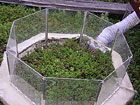

 | |||||||||||||||||
|
|
Journals 2005/2006J. Rebecca Gould Calabro
August 4, 2005 Today was a cold, rainy day despite Abisko being known as the "sunniest, driest place" in Sweden. It was a good day to be indoors. Our morning lecture was an orientation to the Abisko Scientific Research Station. The original station was built in the 1800s as a place where visiting scientists could complete various research assignments relating to climatic conditions in the sub Arctic biomes. The original station burned down and the current station was erected. The station can accommodate about 100 Swedish and visiting foreign scientists at any one time. Scientists are provided with a bed and kitchen facilities and there is ample equipment to conduct research in the field. There are also three cabins located at various points in the Alpine Tundra that scientists can use to conduct comparative studies. I actually stumbled onto one of these sub stations on a walk through a canyon. The field station looked like a miniature version of the Abisko home station. One of the ongoing projects carried out at the Abisko Station is that of climate monitoring. There is a complete set up of stations that monitor the amount of precipitation through the year. An identical set up was found at each of the field stations. Another ongoing project that is being conducted is a simulation UVB experiment that has been going on for the past 15 years! Since the growing season is so short here in the sub Arctic tundra / taiga, the time of research is restricted to the summer time. During the growing seasons, areas of the tundra plants are caged off and provided with different amounts of carbon dioxide and ultraviolet radiation. Both gases are pumped into a clear cage that surrounds the plants. The plants are measured for stem length, and coloration.
Part II: In The Classroom: Human Impact on the Northern Landscapes Henrik's afternoon lecture focused on human interactions throughout the far north. The north has always been a land of exploration. Explorers wanted to find the Northwest Passage. Explorers searched for gold and uncharted land. Niles Bering (did you know that this is where the Bering Sea got its name from?) explored and claimed this sea when he was part of the Russian Navy. Even late into the 20th century, explorers wanted to find the land at the North Pole. The driving force of all these exploratory attempts was to find a northern continent that was rumored to be filled with gold and treasure. Unfortunately the closest we have come to is Ellsmere Island. Ellsmere Island is a considerable journey from the North Pole. Its inhabitants are mostly polar bears. There has also been no gold found there. Nevertheless the 18th and 19th century were known as the Age of Explorers and the Arctic was explored. The consequence of this exploration was not the discovery of a currency but rather was that human beings began to impact the Arctic. Today the Arctic is a haven for tourists who want to explore Earth's last wilderness. Each road that is built makes it that much easier for one more person to experience this mysterious land. This same road changes the wildlife habitat for 20 kilometers (12.43 miles) on either side of the road forever. The Arctic North is a very fragile environment. Everything that we do in Boston, Massachusetts or Tokyo, Japan, or even Abisko, Sweden effects the Arctic North. Earth is subjected to a common weather system and due to air currents pollutants in the northern hemisphere migrate up into the Arctic region. Once they reach the Arctic Circle, the pollutants do nothing more than constantly circle the North Pole. How do we know this? In the 1970s, scientists discovered persistent organic pollutants (POPs) found within the ring seal and polar bear blubber. POPs can be found in any chemical substance that we use in our homes from a can of hairspray to common household supplies. It is unlikely that the polar bears and the ring seals have any interest in grooming their fur or in cleaning the sea ice. Yet the fact remains that these POPs have been found within these animals. More research was conducted and by the 1980s, it was discovered that these chemicals reached the Arctic Ocean by long-range transport. Rather than looking at polar bears and ring seals, scientists looked at human mothers. They found that mothers in the Canadian Northwest Territories were discovered to contain enough POPs within their milk to cause serious health problems in newborn children. Other species effected by these POPs included various mammals and fish inability to reproduce successfully (bears, deer, seals). Also, when bird eggs were evaluated, the shells were found to be too thin to produce a healthy baby bird. Is there any further proof? Science is a lot of speculation as I have discovered in my summer school program. We have the facts that have been discovered. The chemical substances come from technology and from civilized countries. It has been speculated that the only way these chemicals could have gotten to the Arctic was through the air currents. |
||||||||||||||||


